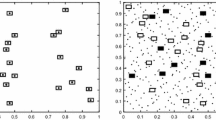Abstract
A spatial sampling design determines where sample locations are placed in a study area. To achieve reliable estimates of population characteristics, the spatial pattern of the sample should be similar to the underlying spatial pattern of the population. A reasonable assumption for natural resources is that nearby locations tend to have more similar response values than distant locations. Hence, sample efficiency can be increased by spreading sample locations evenly over a natural resource. A sample that is well-spread over the resource is called spatially balanced and many spatially balanced sampling designs have been proposed in the statistical literature. Robertson et al. (Environ Ecol Stat 25:305–323, 2018) proposed a sampling design that draws spatially balanced samples using a nested partition. This article modifies their partitioning strategy to spatially order a point resource into a highly structured master frame. Samples of consecutive points from the master frame are spatially balanced and these individual samples can be easily incorporated into a broader spatially balanced design for integrated monitoring. Numerical results show that the master frame’s ordering is effective and that a range of samples drawn from it are spatially balanced.





Similar content being viewed by others
References
Benedetti R, Piersimoni F, Postiglione P (2015) Sampling spatial units for agricultural surveys. Springer, Berlin
Brewer KRW, Hanif M (1983) Sampling with unequal probabilities. Lecture notes in statistics. Springer, New York
Chauvet G, Le Gleut RH (2020) Inference under pivotal sampling: properties, variance estimation, and application to tessellation for spatial sampling. Scand J Stat. https://doi.org/10.1111/sjos.12441
Deville JC, Tillé Y (1998) Unequal probability sampling without replacement through a splitting method. Biometrika 85:89–101
Foster SD, Hosack GR, Lawrence E, Przeslawski R, Hedge P, Caley MJ, Barrett NS, Williams A, Li J, Lynch T et al (2017) Spatially-balanced designs that incorporate legacy sites. Methods Ecol Evol 8:1433–1442
Grafström A (2011) Spatially correlated Poisson sampling. J Stat Plan Inference 142:36–41
Grafström A, Lundström NLP (2013) Why well spread probability samples are balanced. Open J Stat 3:36–41
Grafström A, Schelin L (2014) How to select representative samples. Scand J Stat 41:277–290
Grafström A, Tillé Y (2013) Doubly balanced spatial sampling with spreading and restitution of auxiliary totals. Environmetrics 24:120–131
Grafström A, Lundström NLP, Schelin L (2012) Spatially balanced sampling through the pivotal method. Biometrics 68:514–520
Grafström A, Zhao X, Nylander M, Petersson H (2017) A new sampling strategy for forest inventories applied to the temporary clusters of the Swedish national forest inventory. Can J For Res 47:1161–1167
Halton JH (1960) On the efficiency of certain quasi-random sequences of points in evaluating multi-dimensional integrals. Numer Math 2:84–90
Horvitz DG, Thompson DJ (1952) A generalization of sampling without replacement from a finite universe. J Am Stat Assoc 47:663–685
Kincaid TM, Olsen AR (2016) spsurvey: patial survey design and analysis. \(R\) package version 3.3. URL https://CRAN.R-project.org/package=spsurvey
King AJ (1945) The master sample of agriculture. J Am Stat Assoc 40:38–45
Larsen DP, Olsen AR, Stevens DL Jr (2008) Using a master sample to integrate stream monitoring programs. J Agric Biol Environ Stat 13:243–254
McDonald T (2014) Sampling designs for environmental monitoring. In: Manly BFJ, Navarro Alberto JA (eds) Introduction to ecological sampling. CRC Press, Florida
Price CJ, Price CP (2012) Recycling primes in Halton sequences: an optimization perspective. Adv Model Optim 14:17–29
Robertson BL, Brown JA, McDonald T, Jaksons P (2013) BAS: balanced acceptance sampling of natural resources. Biometrics 3:776–784
Robertson BL, McDonald T, Price CJ, Brown JA (2017) A modification of balanced acceptance sampling. Stat Probab Lett 129:107–112
Robertson BL, McDonald T, Price CJ, Brown JA (2018) Halton iterative partitioning: spatially balanced sampling via partitioning. Environ Ecol Stat 25:305–323
Stevens DL Jr, Olsen AR (2003) Variance estimation for spatially balanced samples of environmental resources. Environmetrics 14:593–610
Stevens DL Jr, Olsen AR (2004) Spatially balanced sampling of natural resources. J Am Stat Assoc 99:262–278
van Dam-Bates P, Gansell O, Robertson BL (2018) Using balanced acceptance sampling as a master sample for environmental surveys. Methods Ecol Evol 9:1718–1726
Wang X, Hickernell FJ (2000) Randomized Halton sequences. Math Comput Model 32:887–899
Yates F (1981) Sampling methods for censuses and surveys, 4th edn. Giffin, London
Zhao X, Grafström A (2020) A sample coordination method to monitor totals of environmental variables. Environmetrics. https://doi.org/10.1002/env.2625
Acknowledgements
We thank two anonymous referees and the editor for valuable comments that led to an improved article.
Author information
Authors and Affiliations
Corresponding author
Additional information
Handling Editor: Pierre Dutilleul
Rights and permissions
About this article
Cite this article
Robertson, B., van Dam-Bates, P. & Gansell, O. Halton iterative partitioning master frames. Environ Ecol Stat 29, 55–76 (2022). https://doi.org/10.1007/s10651-020-00481-1
Received:
Revised:
Accepted:
Published:
Issue Date:
DOI: https://doi.org/10.1007/s10651-020-00481-1




